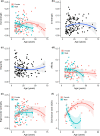Multi-group analysis of grooming network position in a highly social primate
- PMID: 37099520
- PMCID: PMC10132689
- DOI: 10.1371/journal.pone.0284361
Multi-group analysis of grooming network position in a highly social primate
Abstract
Individual variation in complex social behavioral traits, like primate grooming, can be influenced by the characteristics of the individual and those of its social group. To better grasp this complexity, social network analysis can be used to quantify direct and indirect grooming relationships. However, multi-group social network studies remain rare, despite their importance to disentangle individual from group-level trait effects on grooming strategies. We applied social network analysis to grooming data of 22 groups of zoo-housed bonobos and investigated the impact of three individual (sex, age, and rearing-history) and two group-level traits (group size and sex ratio) on five social network measures (out-strength, in-strength, disparity, affinity, and eigenvector centrality). Our results showed age-effects on all investigated measures: for females, all measures except for affinity showed quadratic relationships with age, while in males, the effects of age were more variable depending on the network measure. Bonobos with atypical rearing histories showed lower out-strength and eigenvector centrality, while in-strength was only impacted by rearing history in males. Group size showed a negative association with disparity and eigenvector centrality, while sex ratio did not influence any of the investigated measures. Standardization for group size did not impact the effects of sex and age, indicating the robustness of these findings. Our study provides comprehensive insights into the complexity of grooming behavior in zoo-housed bonobos, and underlines the importance of multi-group analyses for the generalizability of social network analysis results for species as a whole.
Copyright: © 2023 Torfs et al. This is an open access article distributed under the terms of the Creative Commons Attribution License, which permits unrestricted use, distribution, and reproduction in any medium, provided the original author and source are credited.
Conflict of interest statement
The authors have declared that no competing interests exist.
Figures



Similar articles
-
Comparative social grooming networks in captive chimpanzees and bonobos.Primates. 2019 May;60(3):191-202. doi: 10.1007/s10329-018-0670-y. Epub 2018 Jun 21. Primates. 2019. PMID: 29931656
-
The consistency of individual centrality across time and networks in wild vervet monkeys.Am J Primatol. 2021 Feb;83(2):e23232. doi: 10.1002/ajp.23232. Epub 2021 Jan 19. Am J Primatol. 2021. PMID: 33464611
-
Investigating the Function of Mutual Grooming in Captive Bonobos (Pan paniscus) and Chimpanzees (Pan troglodytes).Folia Primatol (Basel). 2020;91(5):481-494. doi: 10.1159/000506308. Epub 2020 Mar 31. Folia Primatol (Basel). 2020. PMID: 32229727
-
Factors underlying party size differences between chimpanzees and bonobos: a review and hypotheses for future study.Primates. 2009 Jul;50(3):197-209. doi: 10.1007/s10329-009-0141-6. Epub 2009 Apr 8. Primates. 2009. PMID: 19353234 Review.
-
Female contributions to the peaceful nature of bonobo society.Evol Anthropol. 2011 Jul-Aug;20(4):131-42. doi: 10.1002/evan.20308. Evol Anthropol. 2011. PMID: 22038769 Review.
Cited by
-
Investigating Changes in Social Networks Following Conflict in Zoo-Housed Bonobos (Pan paniscus).Am J Primatol. 2025 May;87(5):e70047. doi: 10.1002/ajp.70047. Am J Primatol. 2025. PMID: 40418144 Free PMC article.
-
Group-level signatures in bonobo sociality.Evol Hum Sci. 2024 Nov 21;6:e48. doi: 10.1017/ehs.2024.44. eCollection 2024. Evol Hum Sci. 2024. PMID: 39712879 Free PMC article.
-
The effects of early life rearing experiences and age on sociality in captive olive baboons (Papio anubis).Primates. 2025 Jul 19:10.1007/s10329-025-01206-3. doi: 10.1007/s10329-025-01206-3. Online ahead of print. Primates. 2025. PMID: 40683988 Free PMC article.
References
-
- Krause J, Krause P of FB and EJ, Ruxton, Ruxton G, Ruxton IG. Living in Groups. OUP Oxford; 2002.
-
- Croft DP, James R, Krause J. Exploring Animal Social Networks. Princeton University Press; 2008.
-
- Krause J, Lusseau D, James R. Animal social networks: an introduction. Behav Ecol Sociobiol. 2009;63: 967–973.
-
- Sih A, Hanser SF, McHugh KA. Social network theory: new insights and issues for behavioral ecologists. Behav Ecol Sociobiol. 2009;63: 975–988. doi: 10.1007/s00265-009-0725-6 - DOI
Publication types
MeSH terms
LinkOut - more resources
Full Text Sources

